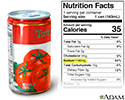Sodium in diet
Diet - sodium (salt); Hyponatremia - sodium in diet; Hypernatremia - sodium in diet; Heart failure - sodium in diet
Sodium is an element that the body needs to work properly. Salt contains sodium.
Function
The body uses sodium to control blood pressure and blood volume. Your body also needs sodium for your muscles and nerves to work properly.
Food Sources
Sodium occurs naturally in most foods. The most common form of sodium is sodium chloride, which is table salt. Milk, beets, and celery also naturally contain sodium. Drinking water also contains sodium, but the amount depends on the source.
Sodium is also added to many food products. Some of these added forms are monosodium glutamate (MSG), sodium nitrite, sodium saccharin, baking soda (sodium bicarbonate), and sodium benzoate. These are in items such as Worcestershire sauce, soy sauce, onion salt, garlic salt, and bouillon cubes.
Processed meats like bacon, sausage, and ham, and canned soups and vegetables also contain added sodium. Fast foods are generally very high in sodium.
Side Effects
Too much sodium in the diet may lead to:
- High blood pressure in some people
-
A serious buildup of fluid in people with
heart failure
,
cirrhosis
of the liver, or kidney disease
Heart failure
Heart failure is a condition in which the heart is no longer able to pump oxygen-rich blood to the rest of the body efficiently. This causes symptom...
 ImageRead Article Now Book Mark Article
ImageRead Article Now Book Mark ArticleCirrhosis
Cirrhosis is scarring of the liver and poor liver function. It is the last stage of chronic liver disease.
 ImageRead Article Now Book Mark Article
ImageRead Article Now Book Mark Article
Recommendations
Sodium in the diet (called dietary sodium) is measured in milligrams (mg). Table salt is 40% sodium. One teaspoon (5 milliliters) of table salt contains 2,300 mg of sodium.
Healthy adults should limit sodium intake to 2,300 mg per day. Adults with high blood pressure should have no more than 1,500 mg per day. Those with congestive heart failure, liver cirrhosis, and kidney disease may need much lower amounts.
There are no specific recommended amounts of sodium for infants, children, and teens. Eating habits and attitudes about food that are formed during childhood are likely to influence eating habits for life. For this reason, it is a good idea for children to avoid eating too much salt .
It is a good idea for children to avoid...
Low-sodium diet; Salt restriction

References
Eckel RH, Jakicic JM, Ard JD, et al. 2013 AHA/ACC guideline on lifestyle management to reduce cardiovascular risk: a report of the American College of Cardiology/American Heart Association Task Force on Practice Guidelines. Circulation . 2014;129(25 Suppl 2):S76-99. PMID: 24222015. www.ncbi.nlm.nih.gov/pubmed/24222015 .
Sacks FM, McManus K. Cardiovascular disease and lifestyle modification. In: Antman EM, Sabatine MS, eds. Cardiovascular Therapeutics: A Companion to Braunwald's Heart Disease . 4th ed. Philadelphia, PA: Elsevier Saunders; 2013:chap 26.
-
Sodium content - illustration
Sodium is an element that the body needs to function properly to regulate blood pressure and blood volume. For individuals who are sodium-sensitive, an increased intake of sodium may contribute to high blood pressure. When watching the intake of sodium, read labels carefully to determine the total sodium content. Canned, packaged, and frozen foods can be particularly high in sodium.
Sodium content
illustration
-
Sodium content - illustration
Sodium is an element that the body needs to function properly to regulate blood pressure and blood volume. For individuals who are sodium-sensitive, an increased intake of sodium may contribute to high blood pressure. When watching the intake of sodium, read labels carefully to determine the total sodium content. Canned, packaged, and frozen foods can be particularly high in sodium.
Sodium content
illustration
Review Date: 4/24/2016
Reviewed By: Emily Wax, RD, The Brooklyn Hospital Center, Brooklyn, NY. Also reviewed by David Zieve, MD, MHA, Isla Ogilvie, PhD, and the A.D.A.M. Editorial team.

